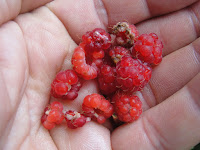Well not really, by unripe I mean 'unripe' and not blackberries but raspberries. I'm always surprised when folk say 'You can find raspberries in the countryside?' and that's why I think people just walk by this delicious fruit thinking that the 'unripe blackberries' because it's the only known fruit of this kind to them.
Whilst not professing to be an expert, it's like many things in that once you get your eye in they just stand out a mile. The thing that usually catches my eye is the colour and look of the leaf.
These are raspberry leaves and have an almost lime green colour to them and feel fairly smooth to the touch.
Compare that to blackberry leaves which are slightly darker and feel rougher and almost leathery compared to raspberry leaves. There can also be some thorns on the main rib on the leaf's underside.

This is the thorny bramble...
Talking of thorns...Anyone who has bushed past a bramble patch will be well acquainted with the multitude of thorns down the long lengths of a bramble (see the bramble leaf picture above).
A more delicate Raspberry cane
Raspberries have more dainty looking stems that can have no thorns, some small but barely raised thorns or slightly longer thorns that are very flexible and almost rubbery and are sometimes red. Suffice to say raspberry canes need to up their game because they are next to no deterrent. If you look closely at the base of the stem in the above picture you'll see some red thorns.
If you still aren't sure that you've hit raspberry cane gold then turn the leaf over. It is always this rather nice grey/ green colour and whilst blackberries can sometimes display this hue it's not 100% of the time (there are apparently dozens and dozens, if not hundreds of blackberry subspecies). This picture also shows off the delicate raspberry leaf and no thorns.
This shot shows off he lime green top surface and the grey/ green underneath perfectly.
The above two shots show raspberries after the flowers have set and the fruits forming.
And here's a shot of some blackberries for comparison.
Scottish raspberry
This bounty of fruits is a crop of Scottish Raspberries (from Galloway), a county that sees favourable growing conditions for them. I also recall going to view Ospreys in the ?Lake district and the car park being full of them too.
Raspberries aren't always that big and can be hard to harvest intact if very ripe. I've also noticed that there can be a little variation in fruit size but not as much as blackberries. The biggest size difference is that between a wild strawberry and a commercially grown fruit. Even if there is no fruit to be had then you'll hopefully know what to look for and will therefore know to revisit.
I'm going to finish on blackberries-If in the late Summer or Autumn you find some blackberries with a grey hue then you've possibly found Dewberries.












No comments:
Post a Comment